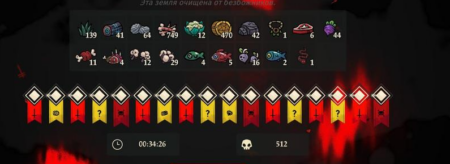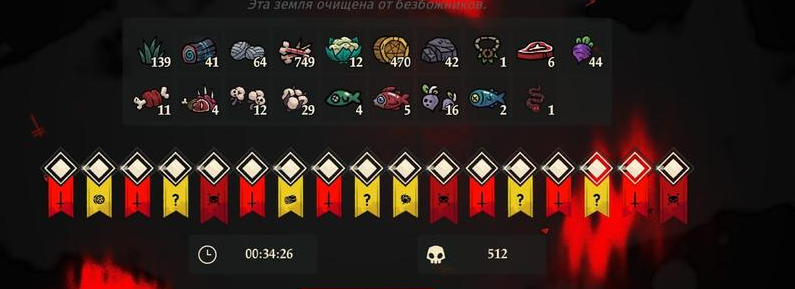More than 56,000 positive reviews on Steam, the opportunity to develop your cult, resurrect the dead and sacrifice the unwanted. A bagel in the style of Isaac, character leveling, 4 biomes, dice, quests and that’s not all that is in this game. But first things first.
The Massive Monster studio has previously developed three games: Never Give Up – a hardcore and bloody platformer similar to Super Meat Boy, a remake of the flash game Give Up. The Adventure Pals is a combat platformer for children, with a clear reference to Adventure Time, and Unicycle Giraffe is a simple Android game about balancing on a unicycle.
Cult of the Lamb shares the visual style of The Adventure Pals, but rivals Never Give Up in brutality. Gameplay-wise, this is a new genre for the studio – roglite/settlement manager. The specificity of the project lies in the combination of naively cute character designs and a rather dark occult world, where funny anthropomorphic animals are sacrificed to cruel gods. Where the mad Owl creates artifacts from parts of dead deities. Where the ant demands that the settlers bring him mushrooms to eat. Clearly a follower of Mario.

At the same time, the game does not slide into Happy Tree Friends with their hysterically joyful dismemberment. Here it is done not so bloody, but darker. The focus is on the feeling of mystery, the occult, and awe at the power of chthonic entities. But all this is somehow childishly fun and positive. Indeed, the best food for cult followers is a stew made from problematic (or old) members of the community. In any case, what you eat can be returned with the help of a ritual, alive, unharmed and rejuvenated. A sort of conversion of faith into food.
From the launch screen, the game immediately makes it clear what it is: a bright, almost blinding white background, where in the center a contrasting lamb hovers above a pentagram in the pose of the crucified Christ, against a triangle background. The main religious and occult symbols are literally collected into one mess.
In the first couple of hours, the game introduces us to Lambert, a simple sheep with a difficult fate, who later becomes our protagonist. All our relatives were exterminated by four bishops, who are a reference to the four horsemen of the apocalypse. And now we are already being led to execution, with a swing of the executioner’s ax… But instead of paradise, a white void awaits us, in which “He Who Waits” is imprisoned by four chains. Wanting to get out, a mysterious entity offers us a deal. Resurrection and a piece of his power to use to take revenge on the offenders, but in return we must kill four bishops and lead the cult of our own name. Naturally, our hero agrees and goes into battle with renewed vigor.
The game is divided into 2 parts
First part. Crusade
Roglight, where we, moving along a schematic map, the final of which is a battle with the boss, can choose the path that interests us with various kinds of events. For example, a game level where you need to go through several rooms, defeating enemies and collecting bonuses. Such dungeons are reminiscent of both the old 2D games of The Legend of Zelda and the relatively new The Binding of Isaac. There are also locations where they simply give you the opportunity to collect resources, withstand several waves of enemies and get a follower, locations with a merchant, or with some kind of bonus/debuff that affects the entire crusade, etc. The most interesting ones are indicated with a question mark, there may be either rare NPCs or notes with lore.
At the end of any crusade, a boss awaits you, they are not difficult. Even the bishops, who are the final test of each biome. True, in some moments the game resembles Bullethell. But, thanks to the bonuses, you can come to the boss and in some cases hit him right in the face without using a dodge until the victory.
Enemies, other than the basic cultists, are unique to each biome. Basically, they are directly related to the final boss and have a phenotype that matches it, plus each biome has a separate resource characteristic only of it.
Location bonuses are issued:
- Tarot cards – passive abilities. The entire crusade is valid, and I did not notice any limitation on their number.
- Weapons – at the beginning of each race we are given a random one. The list includes a sword, dagger, axe, hammer, musket (added in DLC), gloves. Each weapon has its own feature. For example, a dagger has a high attack speed, but only works end-to-end; with gloves, the attack range and damage increase with each combo blow. The DLC added another strong attack, which is applied to a separate button, and is definitely needed to break through shields. For me, the clear outsider among weapons is the gloves; this type of weapon does not stand out in terms of speed or damage.
- Spells – spend energy that is collected from enemies. They can cause damage over an area or at a distance, including homing.
There are also several types of hearts that our hero can pick up. Each type has its own mechanics. In the add-ons, they also added relics of one-time or multiple use, something like an ult, which must be charged by killing enemies.
Second part. Development of the cult
A fairly simple settlement manager and feces cleaning simulator (you really need to clean them up here until you study and build a toilet). The population in the form of bunnies, pigs, cats, deer and other living creatures, our main resource, is recruited mainly either during a crusade or through quests. Supporting their faith and well-being is our main task. If faith falls, the cultist will begin to doubt and possibly leave the cult. Well, if he gets sick or goes hungry, he will die. However, they are, in principle, mortal and will eventually die of old age, but for a small amount of resources you can return the deceased.
At the beginning, there is no automation in the settlement: you cook, clean, and plant crops with your own hands. Then, thanks to faith, which is used here to open new buildings, some of the processes are automated, but you will still have to monitor the settlement and resurrect high-level followers.
Right there in the settlement, rituals are held to receive bonuses, and the hero himself is upgraded, also for faith (but the scale is different).
Why is all this necessary? To gain access to new locations, the required number of settlers is required, and in the endgame you will have to irrevocably sacrifice a resident of a certain level. And there is no such thing as too much pumping.
Another interesting mechanics of commandments, allowing us to play a good or bad god of our choice. For example, you can make cannibalism an absolute norm, or allow the use of followers who died from old age as fertilizer.
In the DLC, they also piled up more possibilities: the reproduction of settlers, the ability to sew clothes for them, sins that need to be collected to improve the visualization of the temple and some rituals , etc.
On the technical side, there are no complaints about the game, everything works smoothly, I didn’t notice any slowdowns, the unity engine performs well in such games. But at the time of release, bugs were encountered periodically. Fortunately, the studio is focused on its projects and quickly corrects mistakes.
The music in the game fits perfectly into the visuals and events. A mixture of cheerful melodies and dark oppressive themes. There are no complaints about the music at all, it surprises and doesn’t get boring even after 50 hours.
It feels like all the ideas that are possible have been crammed into the game; there is even roulette, dice, and simple quests. There are interesting NPCs, and you hope that now their motivation will be revealed to you through quests, but they don’t lead anywhere – they’re just beautiful extras. You seem to learn a little more, but no one tells you the whole story. Everything is presented in poor phrases and you have to figure out most of it yourself. Yes, a good game really doesn’t need a plot, but the settlement and settlers tired me so much at a certain point that I tried to avoid problems with its administration as much as possible. Fortunately, rituals can greatly simplify everything.
Naturally, there is also collecting costumes, appearances, and notes. Some are quite difficult to obtain because you have to rely on extreme randomness, and some are obtained in a very unobvious way.
If this does not deter you, then it makes sense to play the game until the first ending. Endgame play strictly if the game and the atmosphere really hooks you. The second round won’t give you much on top of what you already get.
In any case, I think that this is a real breakthrough for the studio, a qualitative leap in content and content. It’s nice that you get the content DLC for free. This, at a time when some developers are demanding $30 for new content, seems like boundless generosity. The developers and publisher have already created a bunch of merch: soft toys, T-shirts, vinyl records. There are cosmetic and completely unnecessary paid DLC to support the developers. So, if you liked the game, I recommend supporting it.
